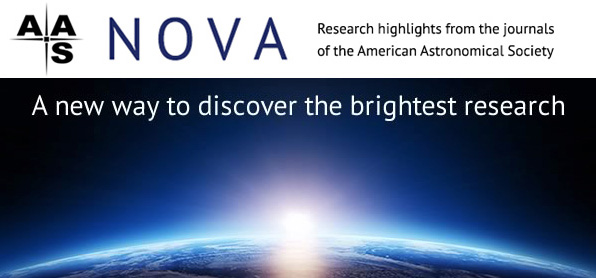Highlights from AAS Nova: 16 November - 9 December 2017

Susanna Kohler American Astronomical Society (AAS)
AAS Nova provides brief highlights of recently published articles from the AAS journals, i.e., The Astronomical Journal (AJ) and The Astrophysical Journal (ApJ), ApJ Letters, and ApJ Supplements. The website's intent is to gain broader exposure for AAS authors and to provide astronomy researchers and enthusiasts with summaries of recent, interesting research across a wide range of astronomical fields.
The following are the AAS Nova highlights from the past two weeks; follow the links to read more, or visit the AAS Nova webpage for more posts.
8 December 2017
Which of Kepler’s Stars Flare?
The habitability of distant exoplanets is dependent upon many factors — one of which is the activity of their host stars. A recent study explores flares on Kepler stars.
6 December 2017
Exploring Our Galaxy’s Thick Disk
What is the structure of the Milky Way’s disk, and how did it form? A new study uses giant stars to explore these questions.
5 December 2017
Planet Frequencies in the Galactic Bulge
Astrobites reports on a survey with the Spitzer Space Telescope to find distant exoplanets acting as tiny lenses.
4 December 2017
Smashing a Jet into a Cloud to Form Stars
What happens when the highly energetic jet from the center of an active galaxy rams into surrounding clouds of gas and dust?
1 December 2017
A Shifting Shield Provides Protection Against Cosmic Rays
The Sun plays an important role in protecting us from cosmic rays, energetic particles that pelt us from outside our solar system. But can we predict when and how it will provide the most protection?
29 November 2017
Are Spinning Black Holes Louder?
Some distant active galaxies are louder in radio wavelengths than others. A new study explores whether this difference could be due to how quickly the supermassive black holes at their centers are spinning.
28 November 2017
Proxima Centauri Sports a Fancy Dust Ring
Astrobites reports on belts of dust discovered around our nearest stellar neighbor, Proxima Centauri.
27 November 2017
Featured Image: Connecting Theory to Observation with the FluxCompensator
One of the challenges of astronomy is connecting theoretical models of distant objects to observations. A new code allows scientists to transform models of sources into images of what we’d expect to observe.


